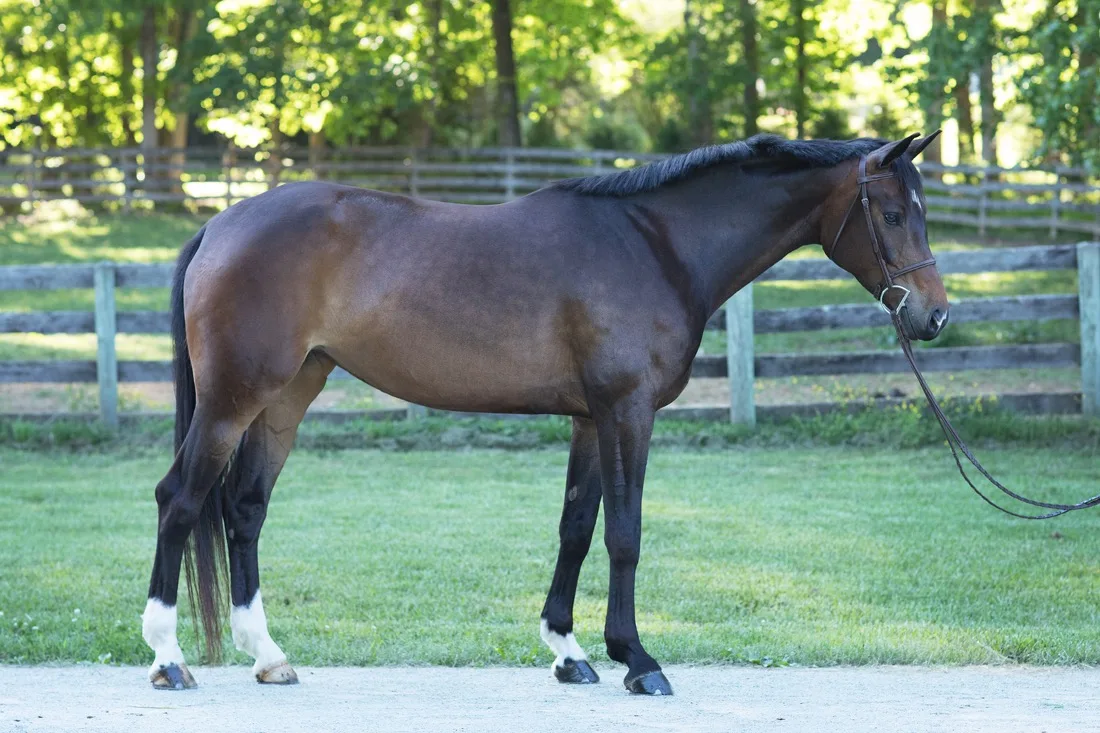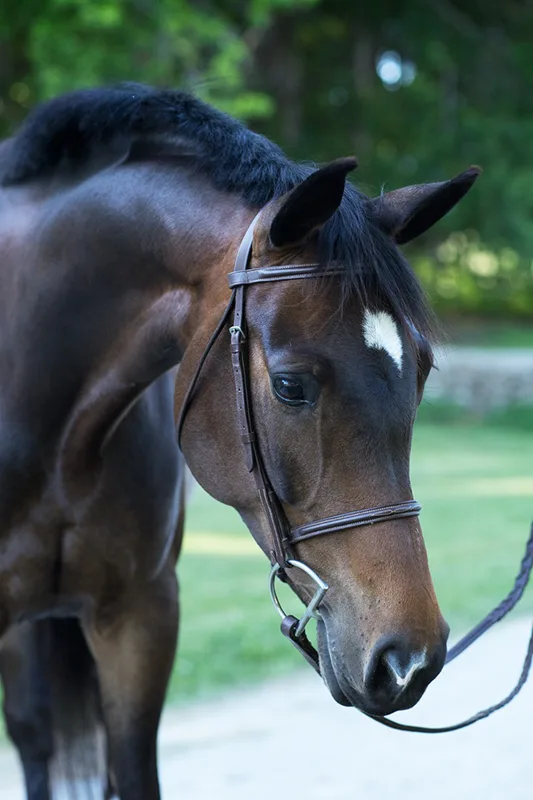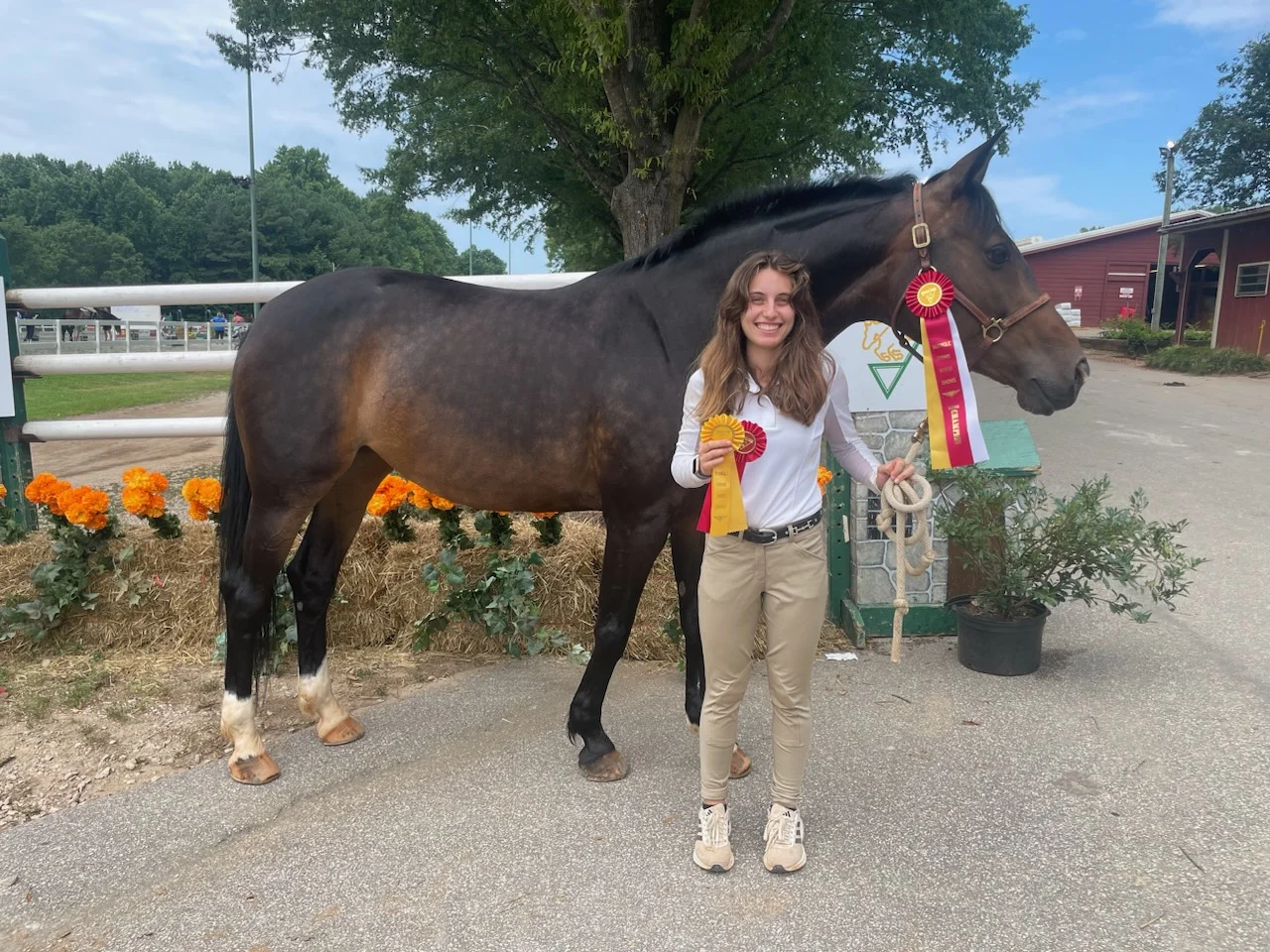Almost immediately, breeder Alisa Shackelford knew her new foal was misnamed. Born in 2010 on a rainy day at Hidden Hill Farm in Bahama, North Carolina, Alpine’s Whisper (Alpine—Sassy, San Ramiro) emerged into the world “playing and leaping around” as the first offspring of Shackelford’s star broodmare Sassy (San Ramiro—Reese, Radjah Z). The name “scream and shout” just seemed more appropriate to Shackelford, but “Whisper” was the name a friend’s daughter had chosen.
“Day 1, we put her in the dry lot, and [it was] kind of torn up, and the stabilization fabric was poking through in a few places,” Shackelford said. “And she was cantering around jumping over the stabilization fabric like she was jumping a little course. She was not a little whisper.”
Whisper progressed naturally through Shackelford’s young horse training program. By 2017, she had graduated to jumping 2’6″ courses. Shackelford was about to market her, but one day around the last week of July 2017, Whisper started to go off her feed.

Shackelford called the closest vet available when she felt something was a little off. The mare responded to Banamine, and since it was the hot peak of North Carolina’s summer, it didn’t seem too alarming.
But Whisper’s health kept subtly oscillating—her gut sounds were fine, and she would eat her food, then wouldn’t finish; respond to Banamine then not. They ran every preliminary test available and isolated her while they waited for results.
Then Whisper spiked a fever, and once it appeared, it kept climbing. As Whisper’s condition declined to where it looked like she may need to be hospitalized, Courtney Culbertson, DVM, of 3H Mobile Equine Vet, took over her care.
All of Whisper’s panels came back negative, but her fever spiked to 106 to 107 degrees. The team gave Whisper 24-hour supportive care, running fluids and icing her feet as they tried different antibiotic combinations to get the fever under control.
“The working diagnosis is just ‘a fever of unknown origin,’ which of course is kind of a catch-all for a horse has a fever, and we don’t know what’s wrong with it,” Culbertson said. “But that was the thing about her that was so strange: No one else was sick on the property; everyone was healthy. It was just this one horse on this huge farm with an acute [onset] of a significant fever. We were sending out all the panels, worried about all the other horses. Everything came back negative. It wasn’t something that contagious; it was specific to this horse.”
The team theorized that Whisper ate a thorn, or something sharp, that punctured her intestine which turned into peritonitis.
“Her SAA [Serum Amyloid A Testing] was off the chart,” Shackelford said. “She had so much inflammation. Her blood work was showing some kind of really bad bacterial infection, and her fever was uncontrollable.”
Culbertson tried a myriad of antibiotics while Shackelford and her staff iced Whisper’s feet and gave her fluids around the clock. Approximately nine days later, Culbertson found an antibiotic combination that eased the fever. But by Aug. 15, Whisper wasn’t standing.
“The horse became endotoxic, had a systemic inflammatory response and foundered in all four feet,” Culbertson recalled. “That was like, ‘OK, this is no longer just a fever. This is a horse on the brink of death.’ ”
Because Whisper’s high fever persisted for so many consecutive days, her body started breaking down. Despite fever subsiding with the specific combination of antibiotics, damage already had been done.
“Endotoxemia will cause a fever, but you can be endotoxic for a lot of reasons,” Culbertson explained. “You could be endotoxic from peritonitis. It essentially just means that you have toxins in the bloodstream and that would be coming from the lungs, from the abdomen, from a terrible wound, a surgical site. It’s a little bit of a vague, but essentially … it’s a systemic inflammatory response, and that is what causes essentially the breakdown in the horse.
“Once you get the systemic inflammatory response syndrome, that’s when you start having trouble with blood flow; you start foundering; you start getting organs that aren’t getting perfused,” she continued. “That’s a sign that you’re headed down the wrong path. Once you get a horse that has this systemic inflammatory response, we’re usually discussing euthanasia because it’s starting to affect the entire body. So, whatever the cause was, at this point is irrelevant because now the whole body is involved. So, the horse is breaking down in front of you.”
Sinking On All Four Feet
Culbertson explained that when horses have inflammation through their entire body, the lamina, which holds the hoof onto the coffin bone, also becomes inflamed. Because horses are so big, when the lamina starts to break down from inflammation, they start foundering. And Whisper’s founder was so severe that all four coffin bones sank and rotated.
“Any sinker case, as they teach you in school, has about a 10% chance of living,” said farrier Jeff Denson, who became an integral part of Whisper’s treatment team. “So, a horse to sink on all four feet is probably 5% chance, if that. Most of the time the stress alone of it will do them in if they can’t get off of the feet.”
Shackelford had a 12-by-24-foot stall made for Whisper so that she could comfortably spread out, and her barn manager Jacque Franco slept in the stall with her nightly. As September rolled around, marking more than a month since Whisper first stopped eating and spiked a fever, Shackelford felt it was time.
ADVERTISEMENT
“She went down to a body score of no more than two; two was probably generous,” Shackelford said. “She looked like a skeleton. Because she couldn’t pick it up, her head was so swollen. It didn’t look like a head anymore; it looked like a block or a balloon. It was the sickest, saddest horse to the point where everyone was like, ‘OK, it’s time. We’re going to have to put this horse down.’ ”
“We’re looking at years of having to potentially regrow a new hoof capsule, or maybe it’ll never happen,” Culbertson said. “Most horses don’t have it in them to go through that process, and most owners don’t have it in them to go through that process. It’s a long, drawn-out process. And some of them, you can spend thousands of dollars, thousands of days, and they still won’t come out the other side—or you have a horse that’s crippled for life. So looking at that, looking down the barrel of years and thousands of dollars, the decision is, correctly, usually to euthanize.”
‘I’m Going To Fight’
When Culbertson came to Hidden Hill to put the mare down, Whisper was laying in the corner of her stall. The vet walked up to place her hand on Whisper’s neck so she could sedate her before euthanasia, and in that moment, Whisper went from laying down to standing on her foundered hind legs, pawing at Culbertson’s face.
“When I tell you that horse came out of her near-death, comatose stupor and tried to kill Courtney, I’m not exaggerating,” Shackelford said. “Reared up, struck out. I don’t know what possessed her, but she was like, ‘You are not. I am not done. You’re not killing me. And I’m going to fight.’ ”
“This horse almost cost me my life,” Culbertson said. “This horse is why I carry good medical insurance.”
They took it as a sign.

“She was on death’s door without feet and emaciated and all the things, but yet she wasn’t giving up,” Shackelford said. “The way I thought about it was, ‘If she’s not giving up, well, I’m not going to give up on her.’ What we decided is that we would not give up on her until she told us that she was done, and clearly she wasn’t.”
“Only a mare would do this,” Culbertson recalled, laughing. “A gelding would have been like, ‘Someone kill me. It’s not going well. My foot hurts.’ A mare is like, ‘Don’t come at me with those syringes.’ We just knew. Horses are good about telling you. A horse that’s done, they get that look in their eyes that they’ve resigned to their fate. They’re prey animals. They know when to give up, and they know when to fight, and this horse was not going down without a fight. The only reason we continued treatment with this horse is because she wasn’t ready.”
The next stage of treatment focused on Whisper’s feet.
Regrowing Her Hooves
“It’s a big rush on getting the best pain control, the best perfusion into the feet, the best trimming job, having X-rays done every two weeks so that we can trim this horse appropriately,” Culbertson said.
By mid-October, Whisper was systemically healthy besides her founder. But dealing with founder in one foot—let alone four—means a roller coaster ride of undulating progress, as it can take eight months to a year for a horse to regrow an entirely new hoof capsule. At first, Denson’s treatment method was to leave her be until she stabilized.
“I just felt like, leave this horse some foot and let her do what she’s going to do, and then we’ll address it after that,” he said. “I think that was the right decision to make.”
Once she stabilized, he put clogs on her, which is a type a type of shoe with a piece of wood that is glued to hard foam material to help the horse strengthen and stabilize. Eventually, he worked on reshaping her feet so that the bone would go back into place.
“[Her] saving grace [was] that she would lay down; a lot of horses won’t lay down,” Denson said. “She felt comfortable in laying down, and she would actually let you work on her laying down. And that horse was so funny—before the horse foundered, we would have to sedate her because she would mess with me and pull back and kick. She was a pistol. And then when she was sick, she was fine. She let me work with her. She didn’t give me no trouble. She just was as good as gold.”
All the while, Shackelford and Franco wanted to make sure Whisper stayed entertained.
“When we knew she was going to try to live, then we were worried about her being really bored—because if they don’t have a reason to live then they’re not going to try as hard,” Shackelford said.
For months, Franco slept on bags of shavings in Whisper’s stall. The mare spent most of her time laying down, but when she would get up, Franco had a ball at hand. The pair would roll the ball across the stall to one another.
“I’ve never seen that before, and especially with a horse that was in that kind of condition,” said Shackelford. “To have the spirit to think that was something fun to do was just amazing.”
ADVERTISEMENT
Through Denson’s persistent and careful work, Whisper became pasture sound. Then one day in August 2019, Shackelford saw her trot around. Out of curiosity, she called Culbertson to see where they were.
‘We Have Films That Look Awesome’
“We were shocked, and we had feet that looked excellent on X-rays,” Culbertson said. “We were laughing, and I was like, ‘Are you sure you brought the right horse?’ At this point, the horse no longer wants me to die. The horse stood great for X-rays. We have films that look awesome. She was out, and she was walking around, and we were kind of like, ‘This horse may actually be OK.’ ”
Shackelford hopped on Whisper and trotted her around, and the mare was calm and sound. Shackelford didn’t ride her again for about a year, but when one intern showed an affinity to Whisper, Shackelford allowed her to slowly work on bringing Whisper back.
“Whisper was just like, ‘This is so much better than being ignored. I love it. You’re going to groom me and feed me treats. I’m going to look pretty, and I get all this attention,’ ” Shackelford recalled. “We just let her do as much as she wanted to do. She never said no, and she never took a lame step.”
Her work over the years came sporadically, as Shackelford calls her a “lifer” at Hidden Hill Farm. But this summer, when Ashley Mullen, who runs AP Equestrian out of Hidden Hill, needed horses for her lessons, Shackelford suggested Whisper.
After Mullen and her students brought her back into shape, they asked if they could take Whisper on her first field trip—and first trailer experience—to a neighbor’s property. She handled it all with such class that on July 21-23, Whisper attended her first show at Triangle Farms Summer Indoors I (North Carolina). With Hannah O’Brien, Whisper earned reserve champion in the beginner crossrails.

“They said, ‘Can we take Whisper?’ said Shackelford. “And I thought, ‘Of course you can take Whisper. Why wouldn’t you take Whisper? But just know she’s never been to a horse show.’ You know from the story how much spirit this horse has; I thought anything was possible. The kid might get bucked off. Who knows what’s going to happen. She literally went into that environment and marched around and was reserve champion.”
Whisper competed again this summer with Avery Hillhouse in the irons, and Shackelford hopes she’ll continue to progress up the levels. But as she learned clearly in September 2017, she’ll follow Whisper’s lead. If she doesn’t want to work anymore, she won’t make her. As long as she loves the work and attention, Whisper will get it.
“I couldn’t have been more proud than I was of this little horse going around in the crossrails and toting some kid around,” Shackelford said, “because every person who’s ever come in contact with that horse was rooting for her when she was trying to die, and every person who had a hand in helping bring her back, those people still care.
“I would never take credit for this,” she added, “because I could never, ever have done that without every piece of that community.”
Denson believes Whisper was just one of those horses that was going to make it. Her will to live surpassed any bookie’s odds.
“If it had been any other horse in that barn, it might have been gone,” he said. “But that particular horse got a little bit more spunk to her than most.”
And for Culbertson, her job naturally comes littered with days of sadness, but her ordeal with Whisper reminded her of the reward and wonder of medicine.
“The thing about being a vet is you deal with so much heartache and so many decisions that have to be made based on finances or work,” she said. “Horses are hard to save; they don’t make it easy. It’s expensive. It’s time consuming. A lot of people don’t have the availability to put in resources like this. We see so many sad cases, so this one kind of came up behind me and surprised me.”
“This horse should have died in 2017. But because of her, I’ll always remember to listen to the horse, because this horse definitely told all of us that she was not ready to go.”
Dr. Courtney Culbertson
Whisper is a horse Culbertson will long remember having defied the odds.
“This horse should have died in 2017,” she said. “But because of her, I’ll always remember to listen to the horse, because this horse definitely told all of us that she was not ready to go.
“It’s one of those things that you kind of forget about it when you’re not looking at it every day, and you think, ‘Oh like thank goodness that case is kind of resolved,’ ” she continued. “And then you have an owner that pulls the horse out for X-rays, and you’re just like, ‘This is modern medicine at its finest.’ This is what we want for everyone. It so often doesn’t happen, but this time we were successful. But all kudos go to the horse, and then the owner and the farrier. It’s teamwork. With any one part not having participated it would have never worked out.”
Do you know a horse or rider who returned to the competition ring after what should have been a life-threatening or career-ending injury or illness? Email Kimberly at kloushin@coth.com with their story.














